Functional Chitosan Derivative and Chitin as Decolorization Materials for Methylene Blue and Methyl Orange from Aqueous Solution
Abstract
1. Introduction
2. Experimental
2.1. Biopolymers and Chemical Compounds
2.2. Synthesis of Chitosan-Grafted-Polyacrylamide
2.3. Characterization of the Synthesized Chitosan Graft Polyacrylamide
2.4. Decolorization Procedure
2.4.1. Decolorization Experiments and Measurement of Dyes Concentration
2.4.2. Evaluation of the Initial pH Effect, Adsorbents Concentration, Temperature and Regeneration Tests on Dyes Decolorization by Chitin and CS-g-PAM
3. Results and Discussion
3.1. Characterization of the Chitosan Derivative (CS-g-PAM): Chemical Structure and Thermostability
3.2. Decolorization Study of MB and MO Solutions by Chitin and CS-g-PAM
3.2.1. Effect of the Initial pH on the Decolorization of the MB and MO
3.2.2. Effect of Contact Time and of Initial Dye (MB and MO) Concentration
3.2.3. Effect of Chitin and Chitosan-g-Polyacrylamide Concentration
3.2.4. Thermodynamic Studies
3.2.5. Regeneration Studies
4. Conclusions
Supplementary Materials
Author Contributions
Funding
Conflicts of Interest
Abbreviations
| CS | Chitosan |
| CH | Chitin |
| AM | Acrylamide |
| CS-g-PAM | Chitosan-grafted-polyacrylamide |
| MB | Methylene blue |
| MO | Methyl orange |
| %G | Percentage of grafting |
| 13C NMR | 13Carbon nuclear magnetic resonance |
| FTIR | Fourier transform infrared |
| TGA | Thermogravimetric analysis |
| DTGA | Differential Thermogravimetric analysis |
| DSC | Differential Scanning Calorimetry |
| Decolorization efficiency (mg/L) | |
| The residual MO and MB concentration at reaction time t (mg/L) | |
| The initial MO and MB concentration (mg/L) | |
| The ultimate residual MO and MB concentration (mg/L) | |
| α | The variation coefficient |
| The empirical rate constant (min−1) | |
| Temperature (°C) | |
| The adsorbent phase concentration at equilibrium (mg/L) | |
| The equilibrium constant | |
| Standard free energy (KJ/mol) | |
| Standard enthalpy change (KJ/mol) | |
| Standard entropy change (KJ/mol∙K) | |
| The sticking probability | |
| The activation energy (KJ/mol) |
References
- Musmarra, D.; Prisciandaro, M.; Capocelli, M.; Karatza, D.; Iovino, P.; Canzano, S.; Lancia, A. Degradation of ibuprofen by hydrodynamic cavitation: Reaction pathways and effect of operational parameters. Ultrason. Sonochem. 2016, 29, 76–83. [Google Scholar] [CrossRef] [PubMed]
- Sarode, S.; Upadhyay, P.; Khosa, M.A.; Mak, T.; Shakir, A.; Song, S.; Ullah, A. Overview of wastewater treatment methods with special focus on biopolymer chitin-chitosan. Int. J. Biol. Macromol. 2019, 121, 1086–1100. [Google Scholar] [CrossRef] [PubMed]
- Rizzo, L.; Malato, S.; Antakyali, D.; Beretsou, V.G.; Đolić, M.B.; Gernjak, W.; Heath, E.; Ivancev-Tumbas, I.; Karaolia, P.; Lado Ribeiro, A.R.; et al. Consolidated vs new advanced treatment methods for the removal of contaminants of emerging concern from urban wastewater. Sci. Total Environ. 2019, 655, 986–1008. [Google Scholar] [CrossRef] [PubMed]
- Yagub, M.T.; Sen, T.K.; Afroze, S.; Ang, H.M. Dye and its removal from aqueous solution by adsorption: A review. Adv. Colloid Interface Sci. 2014, 209, 172–184. [Google Scholar] [CrossRef] [PubMed]
- Srinivasan, A.; Viraraghavan, T. Decolorization of dye wastewaters by biosorbents: A review. J. Environ. Manag. 2010, 91, 1915–1929. [Google Scholar] [CrossRef] [PubMed]
- Mittal, A.; Malviya, A.; Kaur, D.; Mittal, J.; Kurup, L. Studies on the adsorption kinetics and isotherms for the removal and recovery of methyl orange from wastewaters using waste materials. J. Hazard. Mater. 2007, 148, 229–240. [Google Scholar] [CrossRef] [PubMed]
- Gulshan, F.; Yanagida, S.; Kameshima, Y.; Isobe, T.; Nakajima, A.; Okada, K. Various factors affecting photodecomposition of methylene blue by iron-oxides in an oxalate solution. Water Res. 2010, 44, 2876–2884. [Google Scholar] [CrossRef]
- Alventosa-deLara, E.; Barredo-Damas, S.; Alcaina-Miranda, M.I.; Iborra-Clar, M.I. Ultrafiltration technology with a ceramic membrane for reactive dye removal: Optimization of membrane performance. J. Hazard. Mater. 2012, 209–210, 492–500. [Google Scholar] [CrossRef]
- Raghu, S.; Lee, C.W.; Chellammal, S.; Palanichamy, S.; Basha, C.A. Evaluation of electrochemical oxidation techniques for degradation of dye effluents-a comparative approach. J. Hazard. Mater. 2009, 171, 748–754. [Google Scholar] [CrossRef]
- Van der Zee, F.P.; Villaverde, S. Combined an aerobic-aerobic treatment of azo dyes -a short review of bioreactor studies. Water Res. 2005, 39, 1425–1440. [Google Scholar] [CrossRef]
- Mohammadi, N.; Khani, H.; Gupta, V.K.; Amereh, E.; Agarwal, S. Adsorption process of methyl orange dye onto mesoporous carbon material-kinetic and thermodynamic studies. J. Colloid Interface Sci. 2011, 362, 457–462. [Google Scholar] [CrossRef] [PubMed]
- Salaberria, A.M.; Fernandes, S.C.; Diaz, R.H.; Labidi, J. Processing of α-chitin nanofibers by dynamic high pressure homogenization: Charcterization and antifungal activity against A. Niger. Carbohydr. Polym. 2015, 116, 286–291. [Google Scholar] [CrossRef] [PubMed]
- Cho, D.W.; Jeon, B.H.; Chon, C.M.; Schwartz, F.W.; Jeong, Y.; Song, H. Magnetic chitosan composite for adsorption of cationic and anionic dyes in aqueous solution. J. Ind. Eng. Chem. 2015, 28, 60–66. [Google Scholar] [CrossRef]
- Huang, R.; Liu, Q.; Huo, J.; Yang, B. Adsorption of methyl orange onto protonated crosslinked chitosan. Arab. J. Chem. 2017, 10, 24–32. [Google Scholar] [CrossRef]
- Liu, L.; Li, C.; Bao, C.; Jia, Q.; Xiao, P.; Liu, X.; Zhang, Q. Preparation and characterization of chitosan/graphene oxide composites for the adsorption of Au (III) and Pd(II). Talanta 2012, 93, 350–357. [Google Scholar] [CrossRef] [PubMed]
- Hamed, I.; Özogul, F.; Regenstein, J.M. Industrial applications of crustacean by-products (chitin, chitosan, and chitooligosaccharides): A review. Trends Food Sci. Technol. 2016, 48, 40–50. [Google Scholar] [CrossRef]
- Labidi, A.; Salaberria, A.M.; Fernandes, S.C.; Labidi, J.; Abderrabba, M. Adsorption of copper on chitin-based materials: Kinetic and thermodynamic studies. J. Taiwan Inst. Chem. Eng. 2016, 65, 140–148. [Google Scholar] [CrossRef]
- Tanhaei, B.; Ayati, A.; Bamoharram, F.F.; Sillanpää, M. Magnetic EDTA Functionalized Preyssler Cross Linked Chitosan Nanocomposite for Adsorptive Removal of Pb(II) Ions. Clean Soil Air Water 2017, 45, 1700328. [Google Scholar] [CrossRef]
- Nishad, P.A.; Bhaskarapillai, A.; Velmurugan, S. Enhancing the antimony sorption properties of nano titania-chitosan beads using epichlorohydrin as the crosslinker. J. Hazard. Mater. 2017, 334, 160–167. [Google Scholar] [CrossRef]
- Huang, R.; Zhang, L.; Hu, P.; Wang, J. Adsorptive removal of Congo red from aqueous solutions using crosslinked chitosan and crosslinked chitosan immobilized bentonite. Int. J. Biol. Macromol. 2016, 86, 496–504. [Google Scholar] [CrossRef]
- Khanday, W.A.; Asif, M.; Hameed, B.H. Cross-linked beads of activated oil palm ash zeolite/chitosan composite as a bio-adsorbent for the removal of methylene blue and acid blue 29 dyes. Int. J. Biol. Macromol. 2017, 95, 895–902. [Google Scholar] [CrossRef] [PubMed]
- Miao, J.; Zhang, L.C.; Lin, H. A novel kind of thin film composite nanofiltration membrane with sulphated chitosan as the active layer material. Chem. Eng. Sci. 2013, 87, 152–159. [Google Scholar] [CrossRef]
- Elbarbary, A.M.; Ghobashy, M.M. Phosphorylation of chitosan/HEMA interpenetrating polymer network prepared by γ-radiation for metal ions removal from aqueous solutions. Carbohydr. Polym. 2017, 162, 16–27. [Google Scholar] [CrossRef] [PubMed]
- Abdeen, Z.; Mohammad, S.G.; Mahmoud, M.S. Adsorption of Mn (II) Ion on Polyvinyl Alcohol/ Chitosan Dry Blending from aqueous solution. Environ. Nanotech. Monit. Manag. 2014, 3, 1–9. [Google Scholar] [CrossRef]
- Pan, Y.T.; Wang, D.Y. Fabrication of low-fire-hazard flexible poly (vinyl chloride) via reutilization of heavy metal biosorbents. J. Hazard. Mater. 2017, 339, 143–153. [Google Scholar] [CrossRef]
- Maity, J.; Ray, S.K. Enhanced adsorption of methyl violet and congo red by using semi and full IPN of polymethacrylic acid and chitosan. Carbohydr. Polym. 2014, 104, 8–16. [Google Scholar] [CrossRef]
- Guibal, E.; Roussy, J. Coagulation and flocculation of dye-containing solutions using a biopolymer (Chitosan). React. Funct. Polym. 2007, 67, 33–42. [Google Scholar] [CrossRef]
- Chiou, M.S.; Li, H.Y. Adsorption behavior of reactive dye in aqueous solution on chemical cross-linked chitosan beads. Chemosphere 2003, 50, 1095–1105. [Google Scholar] [CrossRef]
- Singh, V.; Sharma, A.K.; Tripathi, D.N.; Sanghi, R. Poly (methylmethacrylate) grafted chitosan: An efficient adsorbent for anionic azo dyes. J. Hazard. Mater. 2009, 161, 955–966. [Google Scholar] [CrossRef]
- Yang, D.; Qiu, L.; Yang, Y. Efficient adsorption of methyl orange using a modified chitosan magnetic composite adsorbent. J. Chem. Eng. Data 2016, 61, 3933–3940. [Google Scholar] [CrossRef]
- Cunha, A.G.; Fernandes, S.C.; Freire, C.S.; Silvestre, A.J.; Neto, C.P.; Gandini, A. What is the real value of chitosan’s surface energy? Biomacromolecules 2008, 9, 610–614. [Google Scholar] [CrossRef] [PubMed]
- Joshi, J.M.; Sinha, V.K. Ceric ammonium nitrate induced grafting of polyacrylamide onto carboxymethyl chitosan. Carbohydr. Polym. 2007, 67, 427–435. [Google Scholar] [CrossRef]
- Lu, Y.; Shang, Y.; Huang, X.; Chen, A.; Yang, Z.; Jiang, Y.; Cai, J.; Gu, W.; Qian, X.; Yang, H.; et al. Preparation of Strong Cationic Chitosan-graft-Polyacrylamide Flocculants and Their Flocculating Properties. Ind. Eng. Chem. Res. 2011, 50, 7141–7149. [Google Scholar] [CrossRef]
- Yuan, B.; Shang, Y.; Lu, Y.; Qin, Z.; Jiang, Y.; Chen, A.; Qian, X.; Wang, G.; Yang, H.; Cheng, R. The Flocculating Properties of Chitosan-graft-Polyacrylamide Flocculants (I)-Effect of the Grafting Ratio. J. Appl. Polym. Sci. 2010, 117, 1876–1882. [Google Scholar] [CrossRef]
- Hosseini, S.; Khan, M.A.; Malekbala, M.R.; Cheah, W.; Choong, T.S. Carbon coated monolith, a mesoporous material for the removal of methyl orange from aqueous phase: Adsorption and desorption studies. Chem. Eng. J. 2011, 171, 1124–1131. [Google Scholar] [CrossRef]
- Albadarin, A.B.; Collins, M.N.; Naushad, M.; Shirazian, S.; Walker, G.; Mangwandi, C. Activated lignin-chitosan extruded blends for efficient adsorption of methylene blue. Chem. Eng. J. 2017, 307, 264–272. [Google Scholar] [CrossRef]
- Fan, J.; Guo, Y.; Wang, J.; Fan, M. Rapid decolorization of azo dye methyl orange in aqueous solution by nanoscale zerovalent iron particles. J. Hazard. Mater. 2009, 166, 904–910. [Google Scholar] [CrossRef]
- Zeng, L.; Xie, M.; Zhang, Q.; Kang, Y.; Guo, X.; Xiao, H.; Xiao, J.H.; Peng, Y.; Luo, J. Chitosan/organic rectorite composite for the magnetic uptake of methylene blue and methyl orange. Carbohydr. Polym. 2015, 123, 89–98. [Google Scholar] [CrossRef]
- Heux, L.; Brugnerotto, J.; Desbrieres, J.; Versali, M.F.; Rinaudo, M. Solid state NMR for determination of degree of acetylation of chitin and chitosan. Biomacromolecules 2000, 1, 746–751. [Google Scholar] [CrossRef]
- Kaity, S.; Isaac, J.; Kumar, P.M.; Bose, A.; Wong, T.W.; Ghosh, A. Microwave assisted synthesis of acrylamide grafted locust bean gum and its application in drug delivery. Carbohydr. Polym. 2013, 98, 1083–1094. [Google Scholar] [CrossRef]
- Prashanth, K.H.; Tharanathan, R.N. Studies on graft copolymerization of chitosan with synthetic monomers. Carbohydr. Polym. 2003, 54, 343–351. [Google Scholar] [CrossRef]
- Saha, S.; Sarkar, P. Arsenic remediation from drinking water by synthesized nano-alumina dispersed in chitosan-grafted polyacrylamide. J. Hazard. Mater. 2012, 227, 68–78. [Google Scholar] [CrossRef] [PubMed]
- Mustafa, I. Methylene blue removal from water using H2SO4 crosslinked magnetic chitosan nanocomposite beads. Microchem. J. 2019, 144, 397–402. [Google Scholar]
- Ma, J.; Fu, K.; Shi, J.; Sun, Y.; Zhang, X.; Ding, L. Ultraviolet-assisted synthesis of polyacrylamide-grafted chitosan nanoparticles and flocculation performance. Carbohydr. Polym. 2016, 151, 565–575. [Google Scholar] [CrossRef] [PubMed]
- Liu, L.; Fan, S.; Li, Y. Removal Behavior of Methylene Blue from Aqueous Solution by Tea Waste: Kinetics, Isotherms and Mechanism. Int. J. Environ. Res. Public Health 2018, 15, 1321. [Google Scholar] [CrossRef] [PubMed]
- Jin, Y.; Zeng, C.; Lü, Q.F.; Yu, Y. Efficient adsorption of methylene blue and lead ions in aqueous solutions by 5-sulfosalicylic acid modified lignin. Int. J. Biol. Macromol. 2019, 123, 50–58. [Google Scholar] [CrossRef] [PubMed]
- Obeid, L.; Bée, A.; Talbot, D.; Jaafar, S.B.; Dupuis, V.; Abramson, S.; Cabuil, V.; Welschbillig, M. Chitosan/maghemite composite: A magsorbent for the adsorption of methyl orange. J. Colloid Interface Sci. 2013, 410, 52–58. [Google Scholar] [CrossRef]
- Wang, S.; Yu, D.; Huang, Y.; Guo, J. The adsorption of sulphonated azo-dyes methyl orange and xylenol orange by coagulation on hollow chitosan microsphere. J. Appl. Polym. Sci. 2011, 119, 2065–2071. [Google Scholar] [CrossRef]
- Shu, H.Y.; Chang, M.C.; Yu, H.H.; Chen, W.H. Reduction of an azo dye Acid Black 24 solution using synthesized nanoscale zerovalent iron particles. J. Colloid Interface Sci. 2007, 314, 89–97. [Google Scholar] [CrossRef]
- Roosta, M.; Ghaedi, M.; Daneshfar, A.; Sahraei, R.; Asghari, A. Optimization of the ultrasonic assisted removal of methylene blue by gold nanoparticles loaded on activated carbon using experimental design methodology. Ultrason. Sonochem. 2014, 21, 242–252. [Google Scholar] [CrossRef]
- Chatterjee, S.; Kumar, A.; Basu, S.; Dutta, S. Application of response surface methodology for methylene blue dye removal from aqueous solution using low cost adsorbent. Chem. Eng. J. 2012, 181–182, 289–299. [Google Scholar] [CrossRef]
- Ghorai, S.; Sarkar, A.; Raoufi, M.; Panda, A.B.; Schönherr, H.; Pal, S. Enhanced Removal of Methylene Blue and Methyl Violet Dyes from Aqueous Solution Using a Nanocomposite of Hydrolyzed Polyacrylamide Grafted Xanthan Gum and Incorporated Nanosilica. Appl. Mater. Interfaces 2014, 6, 4766–4777. [Google Scholar] [CrossRef]
- Dassanayake, R.S.; Rajakaruna, E.; Moussa, H.; Abidi, N. One-pot synthesis of MnO2-chitin hybrids for effective removal of methylene blue. Int. J. Biol. Macromol. 2016, 93, 350–358. [Google Scholar] [CrossRef] [PubMed]
- Wang, Y.; Zhang, X.; He, X.; Zhang, W.; Zhang, X.; Lu, C. In situ synthesis of MnO2 coated cellulose nanofibers hybrid for effective removal of methylene blue. Carbohydr. Polym. 2014, 110, 302–308. [Google Scholar] [CrossRef] [PubMed]
- Ghaedi, M.; reza Rahimi, M.; Ghaedi, A.M.; Tyagi, I.; Agarwal, S.; Gupta, V.K. Application of least squares support vector regression and linear multiple regression for modeling removal of methyl orange onto tin oxide nanoparticles loaded on activated carbon and activated carbon prepared from Pistacia atlantica wood. J. Colloid Interface Sci. 2016, 461, 425–434. [Google Scholar] [CrossRef] [PubMed]
- Tanhaei, B.; Ayati, A.; Lahtinen, M.; Sillanpää, M. Preparation and characterization of a novel chitosan/Al2O3/magnetite nanoparticles composite adsorbent for kinetic, thermodynamic and isotherm studies of Methyl Orange adsorption. Chem. Eng. J. 2015, 259, 1–10. [Google Scholar] [CrossRef]
- Arshadi, M.; Vahid, F.S.; Salvacion, J.W.L.; Soleymanzadeh, M. A practical organometallic decorated nano-size SiO2-Al2O3 mixed-oxides for methyl orange removal from aqueous solution. Appl. Surf. Sci. 2013, 280, 726–736. [Google Scholar] [CrossRef]
- Zhao, H.; Zhang, G.; Chong, S.; Zhang, N.; Liu, Y. MnO2/CeO2 for catalytic ultrasonic decolorization of methyl orange: Process parameters and mechanisms. Ultrason. Sonochem. 2015, 27, 474–479. [Google Scholar] [CrossRef]
- Lu, Y.; Jiang, B.; Fang, L.; Ling, F.; Gao, J.; Wu, F.; Zhang, X. High performance NiFe layered double hydroxide for methyl orange dye and Cr(VI) adsorption. Chemosphere 2016, 152, 415–422. [Google Scholar] [CrossRef]
- Wong, S.; Tumari, H.H.; Ngadi, N.; Mohamed, N.B.; Hassan, O.; Mat, R.; Amin, N.A.S. Adsorption of anionic dyes on spent tea leaves modified with polyethyleneimine (PEI-STL). J. Clean. Prod. 2019, 206, 394–406. [Google Scholar] [CrossRef]
- Ding, S.; Sun, S.; Xu, H.; Yang, B.; Liu, Y.; Wang, H.; Chen, D.; Zhang, R. Preparation and adsorption property of graphene oxide by using waste graphite from diamond synthesis industry. Mater. Chem. Phys. 2019, 221, 47–57. [Google Scholar] [CrossRef]
- Li, X.; Wang, Z.; Ning, J.; Gao, M.; Jiang, W.; Zhou, Z.; Li, G. Preparation and characterization of a novel polyethyleneimine cation-modified persimmon tannin bioadsorbent for anionic dye adsorption. J. Environ. Manag. 2018, 217, 305–314. [Google Scholar] [CrossRef] [PubMed]
- Marrakchi, F.; Ahmed, M.J.; Khanday, W.A.; Asif, M.; Hameed, B.H. Mesoporous-activated carbon prepared from chitosan flakes via single-step sodium hydroxide activation for the adsorption of methylene blue. Int. J. Biol. Macromol. 2017, 98, 233–239. [Google Scholar] [CrossRef] [PubMed]
- Salehi, E.; Madaeni, S.S.; Rajabi, L.; Vatanpour, V.; Derakhshan, A.A.; Zinadini, S.; Ghorabi, S.; Monfared, H.A. Novel chitosan/poly(vinyl) alcohol thin adsorptive membranes modified with amino functionalized multi-walled carbon nanotubes for Cu(II) removal from water: Preparation, characterization, adsorption kinetics and thermodynamics. Sep. Purif. Technol. 2012, 89, 309–319. [Google Scholar] [CrossRef]
- Bazargan-Lari, R.; Zafarani, H.R.; Bahrololoom, M.E.; Nemati, A. Removal of Cu (II) ions from aqueous solutions by low-cost natural hydroxyapatite/chitosan composite: Equilibrium, kinetic and thermodynamic studies. J. Taiwan Inst. Chem. Eng. 2014, 45, 1642–1648. [Google Scholar] [CrossRef]
- Boparai, H.K.; Joseph, M.; O’Carroll, D.M. Kinetics and thermodynamics of cadmium ion removal by adsorption onto nano zerovalent iron particles. J. Hazard. Mater. 2011, 186, 458–465. [Google Scholar] [CrossRef] [PubMed]
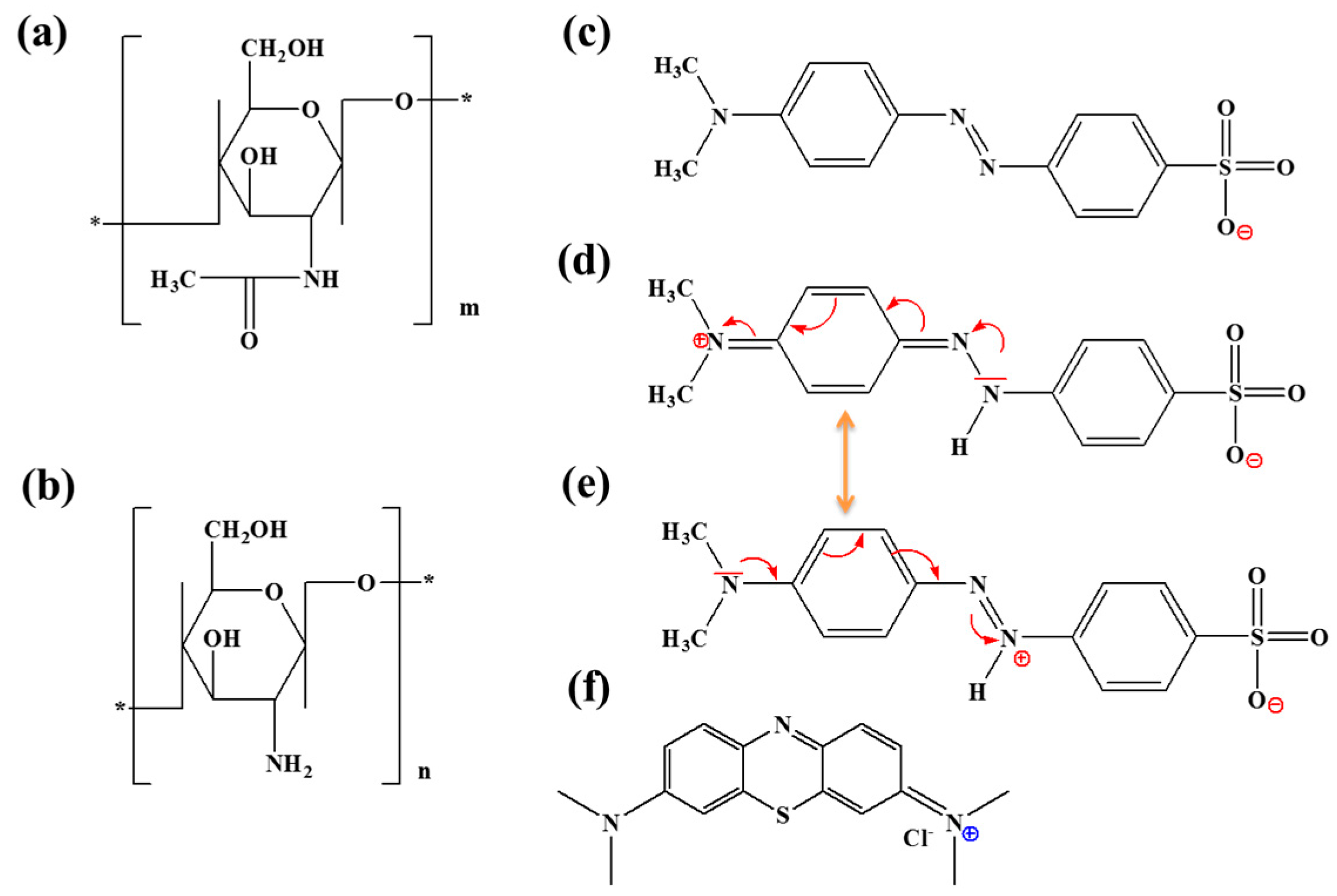
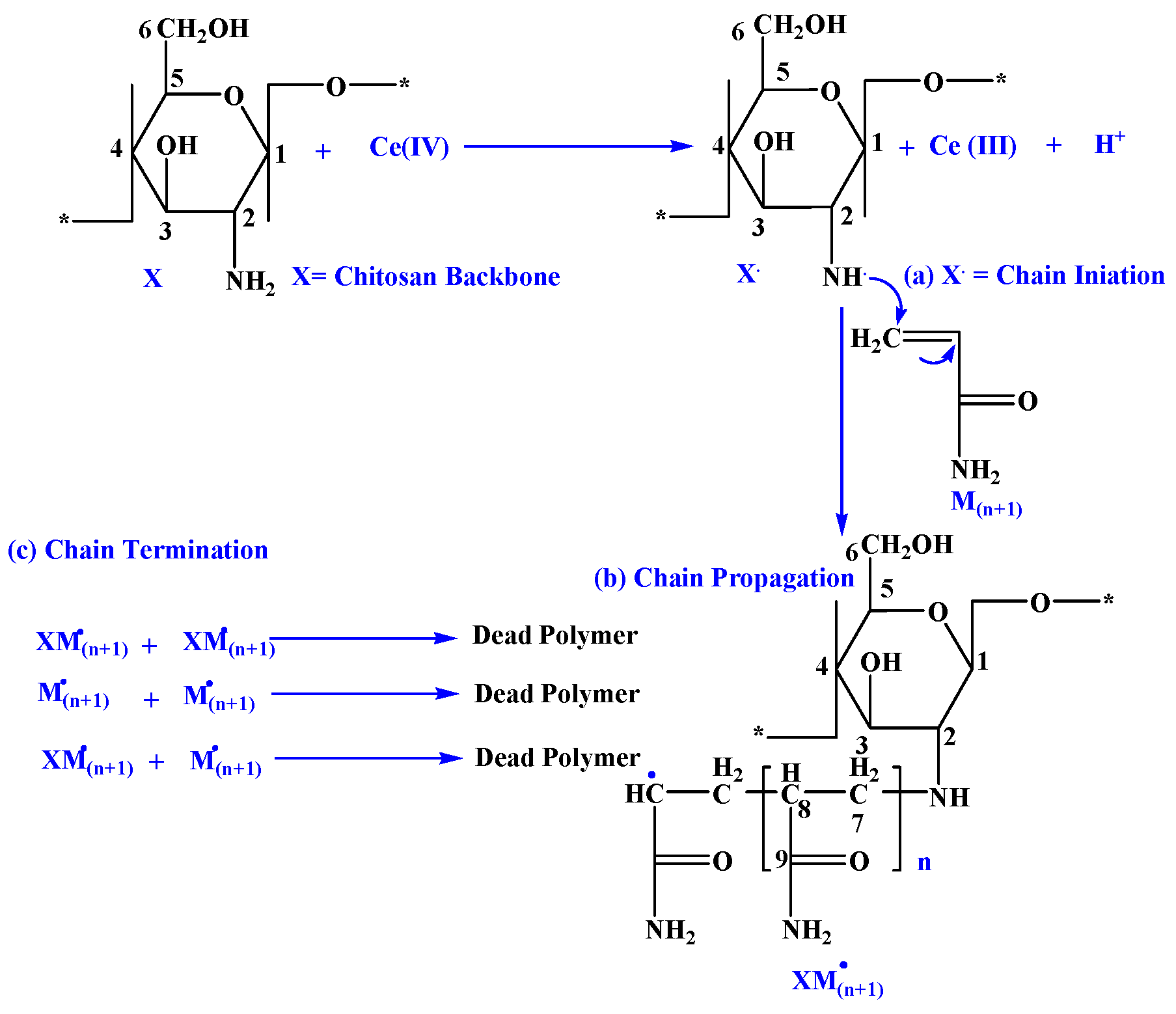

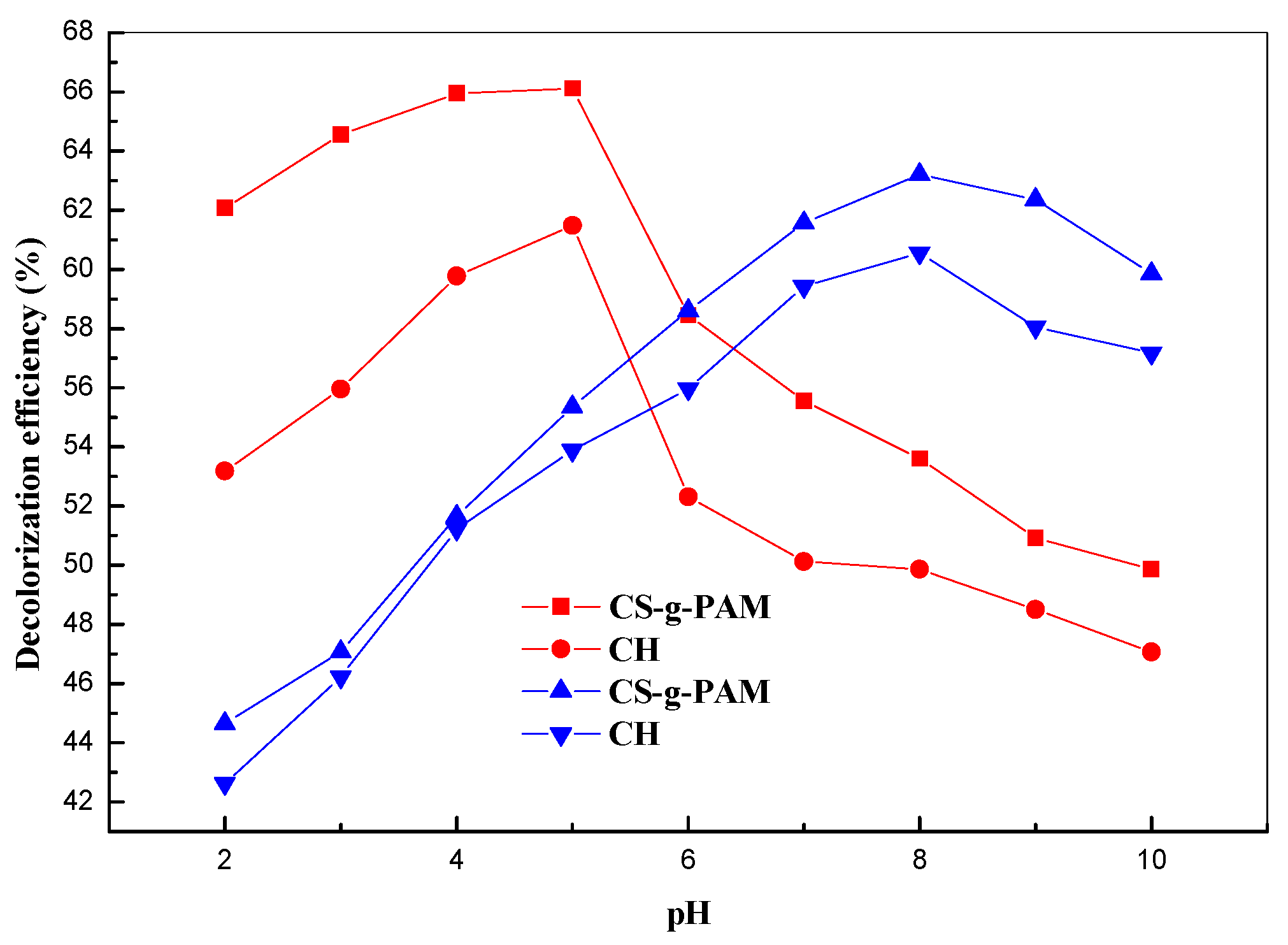
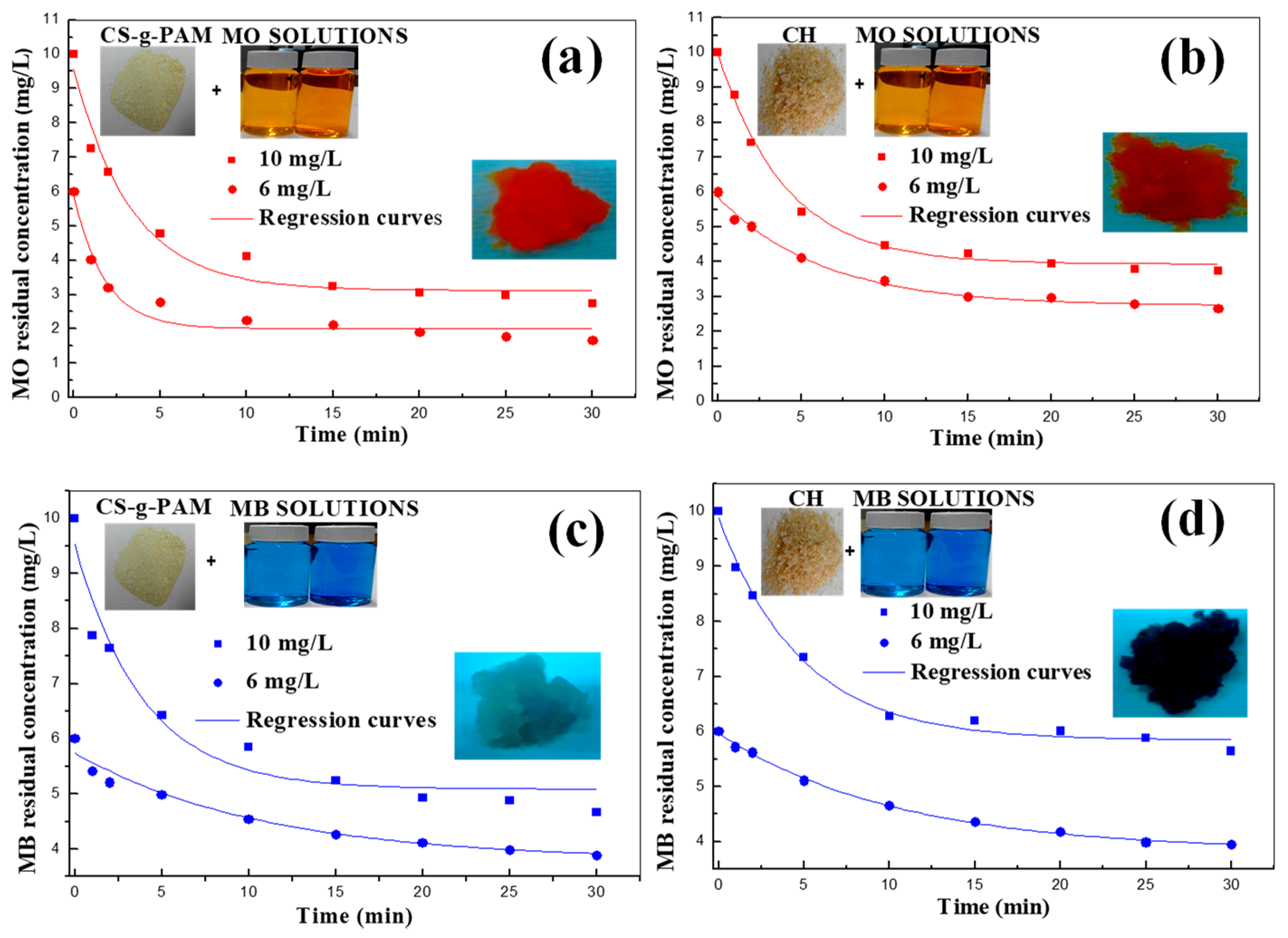
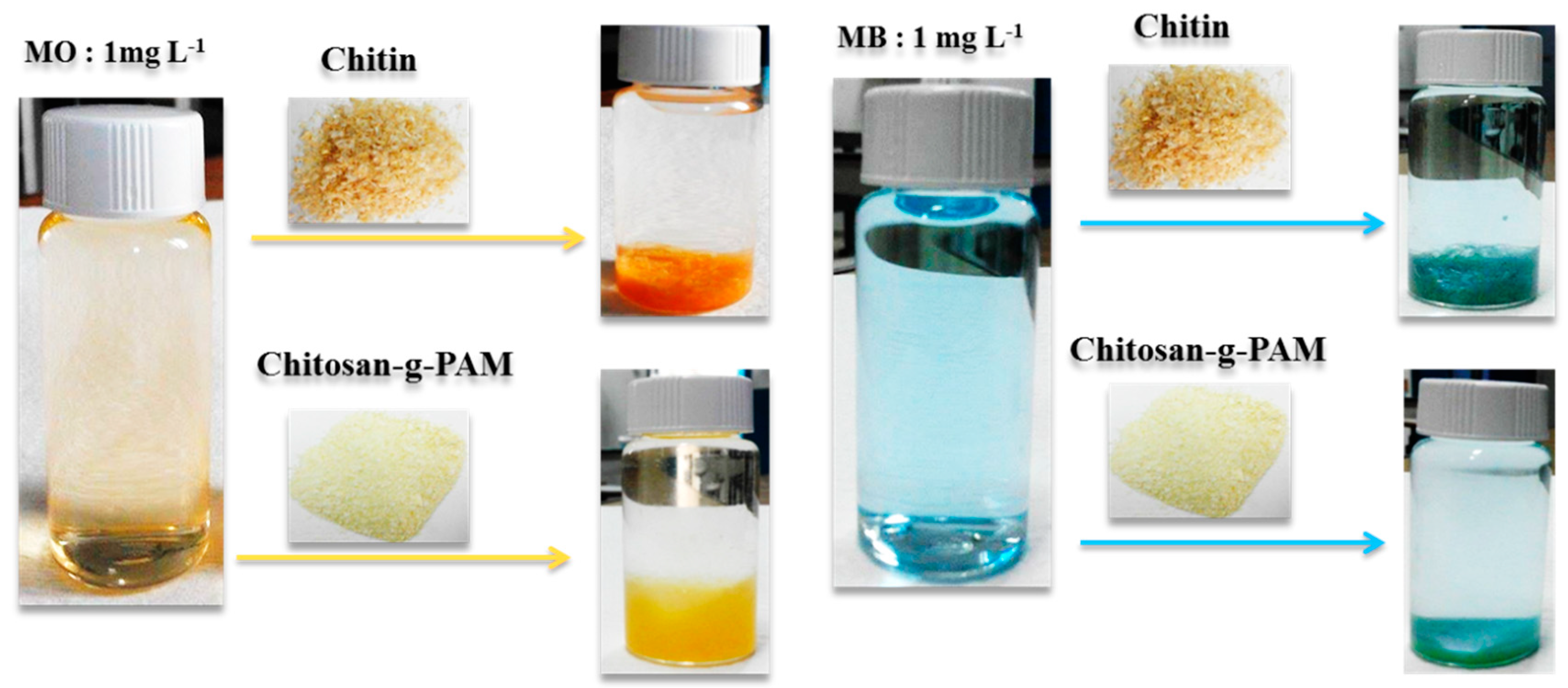

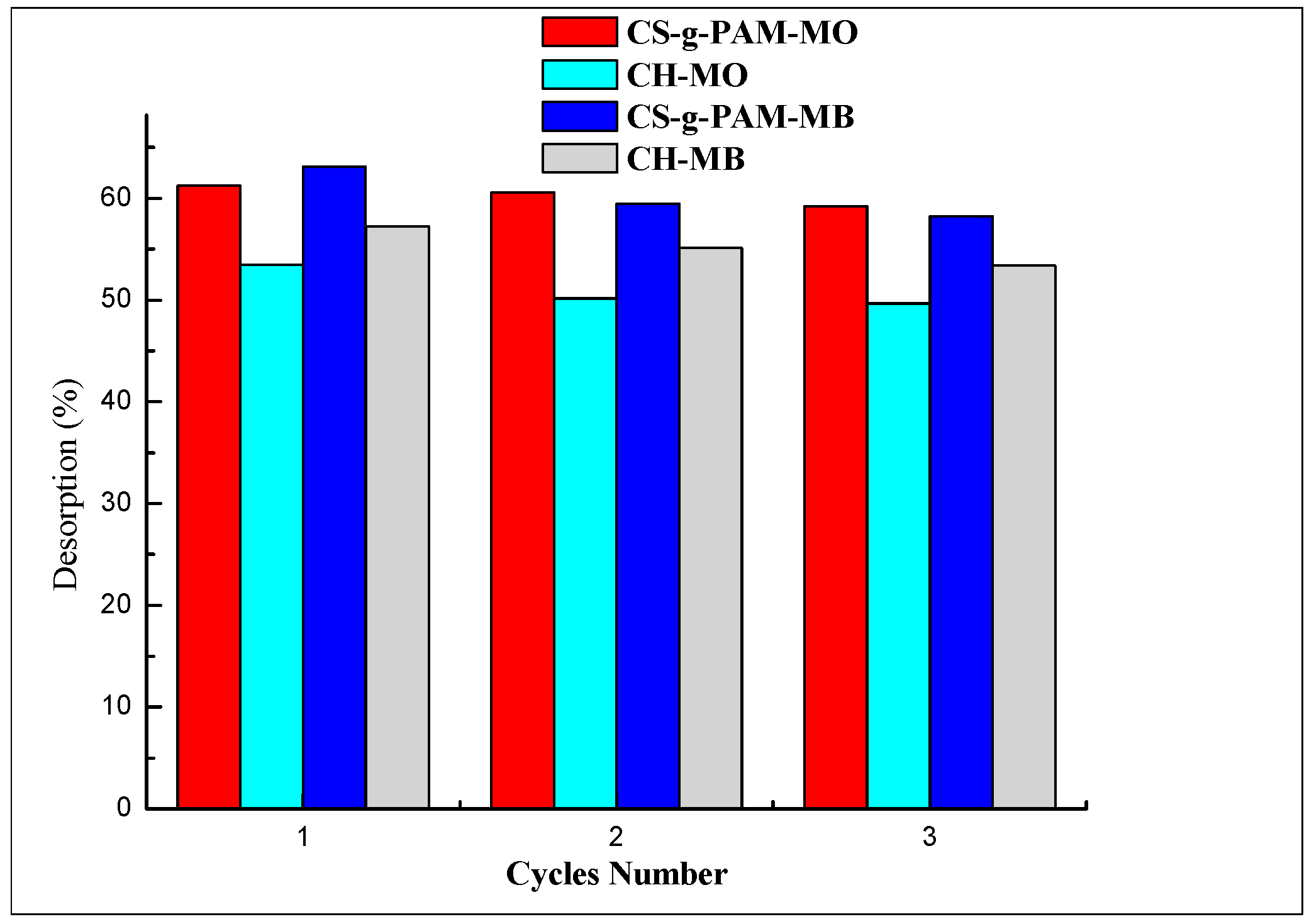
| Material | Dye | C0 (mg/L) | Dose (g L−1) | Initial pH | T °C | K (min−1) | α | ||
|---|---|---|---|---|---|---|---|---|---|
| CS-g-PAM | MO | 10 | 3.0 | 5.0 | 25 | 3.12 | 0.29 | 0.98 | 0.93 |
| 6.0 | 3.0 | 5.0 | 25 | 2.01 | 0.55 | 0.98 | 0.97 | ||
| CH | MO | 10 | 3.0 | 5.0 | 25 | 3.93 | 0.24 | 0.99 | 0.99 |
| 6.0 | 3.0 | 5.0 | 25 | 2.74 | 0.16 | 0.99 | 0.95 | ||
| CS-g-PAM | MB | 10 | 3.0 | 8.0 | 25 | 5.08 | 0.25 | 0.97 | 0.9 |
| 6.0 | 3.0 | 8.0 | 25 | 3.80 | 0.09 | 0.98 | 0.88 | ||
| CH | MB | 10 | 3.0 | 8.0 | 25 | 5.84 | 0.20 | 0.99 | 0.97 |
| 6.0 | 3.0 | 8.0 | 25 | 3.83 | 0.09 | 0.99 | 0.98 |
| Decolorizing Agent | Percent Removal (%) | [Decolorizing Agent], (g/L) | Reference | |
|---|---|---|---|---|
| MB | MO | |||
| Gold nanoparticles loaded on activated carbon | >95 in 1.6 min | - | 0.01 | [50] |
| Charred Parthenium (CP) | 93.4 in 3.0 h | - | 0.22 | [51] |
| Nanocomposite of Hydrolyzed Polyacrylamide Grafted Xanthan Gum and Incorporated Nanosilica | 99.4 in 20 min | - | 0.04 | [52] |
| MnO2-chitin hybrid | 99.9 in 2.5 min | - | 0.35 | [53] |
| MnO2-CNF hybrid | 99.8 in 2.0 min | - | 1.0 | [54] |
| Tin oxide nanoparticles loaded on activated carbon (SnO2-NP-AC) activated carbon prepared from wood tree Pistaciaatlantica (AC-PAW) | - - | >95 in 1.0 h >95 in 1.0 h | 0.015 0.08 | [55] |
| Chitosan/Al2O3/magnetitenanoparticles composite | - | 50 in 2 min | 0.4 | [56] |
| SiO2-Al2O3mixed-oxides | - | 85 in 25 min | 0.03 | [57] |
| MnO2/CeO2catalyst | - | 90 in 10 min | 1.0 | [58] |
| NiFe layered double hydroxides (LDHs) | - | 92 in 10 min | 0.02 | [59] |
| Chitin/CS-g-PAM | ≈100/100 in 30 min | 3.0 | This study | |
| Material | Dye | T (°C) | |||
|---|---|---|---|---|---|
| CS-g-PAM | MO | +19.94 | +0.07 | −2.11 | 25 |
| −2.85 | 35 | ||||
| −3.59 | 45 | ||||
| −4.33 | 55 | ||||
| CH | MO | +16.45 | +0.06 | −1.17 | 25 |
| −2.33 | 35 | ||||
| −2.84 | 45 | ||||
| −3.55 | 55 | ||||
| CS-g-PAM | MB | +17.53 | +0.06 | −1.24 | 25 |
| −1.87 | 35 | ||||
| −2.50 | 45 | ||||
| −3.13 | 55 | ||||
| CH | MB | +18.38 | +0.06 | −0.69 | 25 |
| −1.33 | 35 | ||||
| −1.97 | 45 | ||||
| −2.61 | 55 |
| Material | Dye | |||
|---|---|---|---|---|
| CS-g-PAM | MO | 0.00048 | 15.80 | 0.96 |
| CH | MO | 0.0020 | 12.34 | 0.99 |
| CS-g-PAM | MB | 0.0023 | 12.55 | 0.97 |
| CH | MB | 0.0026 | 12.48 | 0.96 |
© 2019 by the authors. Licensee MDPI, Basel, Switzerland. This article is an open access article distributed under the terms and conditions of the Creative Commons Attribution (CC BY) license (http://creativecommons.org/licenses/by/4.0/).
Share and Cite
Labidi, A.; Salaberria, A.M.; Fernandes, S.C.M.; Labidi, J.; Abderrabba, M. Functional Chitosan Derivative and Chitin as Decolorization Materials for Methylene Blue and Methyl Orange from Aqueous Solution. Materials 2019, 12, 361. https://doi.org/10.3390/ma12030361
Labidi A, Salaberria AM, Fernandes SCM, Labidi J, Abderrabba M. Functional Chitosan Derivative and Chitin as Decolorization Materials for Methylene Blue and Methyl Orange from Aqueous Solution. Materials. 2019; 12(3):361. https://doi.org/10.3390/ma12030361
Chicago/Turabian StyleLabidi, Abdelkader, Asier M. Salaberria, Susana C. M. Fernandes, Jalel Labidi, and Manef Abderrabba. 2019. "Functional Chitosan Derivative and Chitin as Decolorization Materials for Methylene Blue and Methyl Orange from Aqueous Solution" Materials 12, no. 3: 361. https://doi.org/10.3390/ma12030361
APA StyleLabidi, A., Salaberria, A. M., Fernandes, S. C. M., Labidi, J., & Abderrabba, M. (2019). Functional Chitosan Derivative and Chitin as Decolorization Materials for Methylene Blue and Methyl Orange from Aqueous Solution. Materials, 12(3), 361. https://doi.org/10.3390/ma12030361








